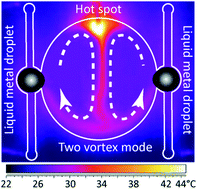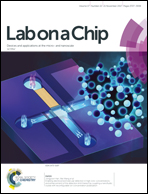Customised spatiotemporal temperature gradients created by a liquid metal enabled vortex generator†
Abstract
Generating customised temperature gradients in miniaturised flow-free liquid chambers is challenging due to the dominance of diffusion. Inducing internal flows in the form of vortices is an effective strategy for overcoming the limitations of diffusion in such environments. Vortices can be produced by applying pressure, temperature and electric potential gradients via miniaturised actuators. However, the difficulties associated with the fabrication, integration, maintenance and operation of such actuators hinder their utility. Here, we utilise liquid metal enabled pumps to induce vortices inside a miniaturised liquid chamber. The configuration and rotational velocity of these vortices can be controlled by tuning the polarity and frequency of the energising electrical signal. This allows creation of customised spatial temperature gradients inside the chamber. The absence of conventional moving elements in the pumps facilitates the rapid reconfiguration of vortices. This enables quick transition from one temperature profile to another, and creates customised spatiotemporal temperature gradients. This allows temperature oscillation from 35 to 62 °C at the hot spot, and from 25 to 27 °C at the centre of the vortex within 15 seconds. Our liquid metal enabled vortex generator can be fabricated, integrated and operated easily, and offers opportunities for studying thermo-responsive materials and biological samples.



 Please wait while we load your content...
Please wait while we load your content...